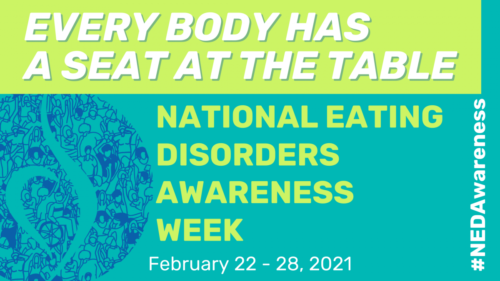 The goal of National Eating Disorders Awareness Week (#NEDAwareness) is to shine the spotlight on eating disorders by educating the public, spreading a message of hope, and putting lifesaving resources into the hands of those in need.
The goal of National Eating Disorders Awareness Week (#NEDAwareness) is to shine the spotlight on eating disorders by educating the public, spreading a message of hope, and putting lifesaving resources into the hands of those in need.
Every Body Has a Seat at the Table. In a field where marginalized communities continue to be underrepresented, conversations on raising awareness, challenging systemic biases, and sharing stories from all backgrounds and experiences are welcomed.
For more information and to build a movement to raise awareness and support those affected by eating disorders, visit https://www.nationaleatingdisorders.org/get-involved/nedawareness
###
What Are Eating Disorders?
Eating disorders are mental health conditions marked by an obsession with food or body shape. They can affect anyone but are most prevalent among young women.
What Causes Eating Disorders?
Eating disorders may be caused by several factors including genetics, brain biology, personality traits, and cultural ideals.
- One factor is genetics. Twin and adoption studies involving twins who were separated at birth and adopted by different families provide some evidence that eating disorders may be hereditary. This type of research has generally shown that if one twin develops an eating disorder, the other has a 50% likelihood of developing one too.
- Personality traits are another cause. In particular, neuroticism, perfectionism, and impulsivity are three personality traits often linked to a higher risk of developing an eating disorder.
- Other potential causes include perceived pressures to be thin, cultural preferences for thinness, and exposure to media promoting such ideals. Certain eating disorders appear to be mostly nonexistent in cultures that haven’t been exposed to Western ideals of thinness.
- More recently, experts have proposed that differences in brain structure and biology may also play a role in the development of eating disorders.
Neuroticism: Defined as a tendency toward anxiety, depression, self-doubt, and other negative feelings.
Perfectionism: Defined as the need to be or appear to be perfect, or even to believe that it’s possible to achieve perfection. It is typically viewed as a positive trait rather than a flaw
Impulsivity: Defined as a tendency to act on a whim, displaying behavior characterized by little or no forethought, reflection, or consideration of the consequences.
https://www.healthline.com/nutrition/common-eating-disorders
Common Types of Eating Disorders and their Symptoms
Anorexia Nervosa
People with anorexia nervosa may limit their food intake or compensate for it through various purging behaviors. They have an intense fear of gaining weight, even when severely underweight. Many people with anorexia are often preoccupied with constant thoughts about food, and some may obsessively collect recipes or hoard food.
Obsessive-Compulsive Disorder
Obsessive-compulsive disorder (OCD) is a chronic mental health condition characterized by obsessions which lead to compulsive behaviors. People often double check to make sure they’ve locked the front door or always wear their lucky socks on game days. OCD goes beyond double checking something or practicing a game day ritual. Someone diagnosed with OCD feels compelled to act out certain rituals repeatedly, even if they don’t want to — and even if it complicates their life unnecessarily.
Bulimia Nervosa
People with bulimia nervosa eat large amounts of food in short periods of time, then purge. They fear gaining weight despite being at a normal weight. Bulimia tends to develop during adolescence and early adulthood and appears to be less common among men than women.
Binge Eating Disorder
People with binge eating disorder regularly and uncontrollably consume large amounts of food in short periods of time. Unlike people with other eating disorders, they do not purge.
Binge eating disorder is believed to be one of the most common eating disorders, especially in the United States. It typically begins during adolescence and early adulthood, although it can develop later on. Individuals with this disorder have symptoms similar to those of bulimia or the binge eating subtype of anorexia.
Pica
Individuals with pica tend to crave and eat non-food substances. This disorder may particularly affect children, pregnant women, and individuals with mental disabilities. Individuals with pica crave non-food substances, such as ice, dirt, soil, chalk, soap, paper, hair, cloth, wool, pebbles, laundry detergent, or cornstarch. Individuals with pica may be at an increased risk of poisoning, infections, gut injuries, and nutritional deficiencies. Depending on the substances ingested, pica may be fatal.
Rumination Disorder
Rumination disorder can affect people at all stages of life. People with the condition generally regurgitate the food they’ve recently swallowed. Then, they chew it again and either swallow it or spit it out. This disorder can develop during infancy, childhood, or adulthood. In infants, it tends to develop between 3–12 months of age and often disappears on its own. Children and adults with the condition usually require therapy to resolve it.
Avoidant/Restrictive Food Intake Disorder
Avoidant/Restrictive Food Intake Disorder (ARFID) is an eating disorder that causes people to undereat. This is either due to a lack of interest in food or an intense distaste for how certain foods look, smell, or taste. Although ARFID generally develops during infancy or early childhood, it can persist into adulthood. What’s more, it’s equally common among men and women. Individuals with this disorder experience disturbed eating either due to a lack of interest in eating or distaste for certain smells, tastes, colors, textures, or temperatures.
Purging disorder
Individuals with purging disorder often use purging behaviors, such as vomiting, laxatives, diuretics, or excessive exercising, to control their weight or shape. However, they do not binge.
Night eating syndrome
Individuals with this syndrome frequently eat excessively, often after awakening from sleep.
For more information on eating disorders:
https://www.healthline.com/health/ocd/social-signs#ocpd-vs-ocd
https://www.nimh.nih.gov/health/topics/eating-disorders/index.shtml
https://www.nationaleatingdisorders.org/help-support/contact-helpline
https://www.psychiatry.org/patients-families/eating-disorders/what-are-eating-disorders